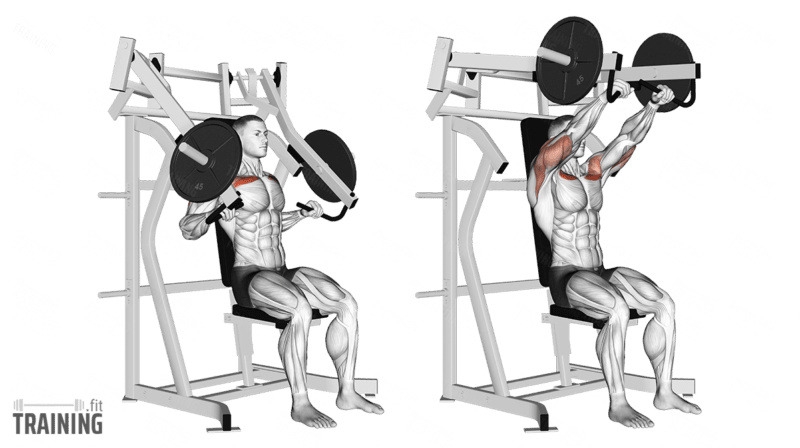Incline Chest Press
Isolation exercise, MachineOverview

Main muscles
- Chest: Large pectoral muscle
(Musculus pectoralis major) - Chest: Small pectoral muscle
(Musculus pectoralis minor)
Training plans
Here you can find example plans for incline chest press training:
Incline Chest Press: Basics and alternatives

Involved main muscle groups:
Incline Chest Press
The Incline Chest Press is a variation of the highly popular machine exercise for the chest. The movement is similar to the conventional “flat” chest press: by pushing weight away from your chest, you work your chest muscles. The incline backrest and machine guidance focus the muscle training on the upper part of the chest.
This exercise mirrors the incline bench press with a barbell. Since the movement is guided by the machine, the chest press is seen as a stronger isolation exercise due to less stabilization needed from other muscle groups. This can be particularly helpful for beginners to get a feel for the movement and prepare their muscles for free weight exercises. It can also be useful for exhausting the chest muscles after an intense weightlifting session.
Consider the Incline Chest Press as a complement to the Butterfly, which is another machine exercise for the chest with a different movement and focus on the middle part of the chest.
Correct Execution
Variation options in the Incline Chest Press are limited since there’s usually only one pair of grips. Pick a grip width that aligns your forearms and hands in a forward-pointing line.
Adjust the seat cushion height so that your hands are about at the level of your lower chest.
Video Tutorial
Step-by-Step Instructions
Sit on the seat cushion and lean back. Your head and back should touch the backrest. Plant your feet firmly on the ground to stabilize your body in this position.
Hold the handles with an upper grip (palms facing up).
Push the weight slightly forward to feel tension in your chest. You’re now in the starting position.
Next, push the handles forward or upward. Keep your back and head pressed against the backrest. Don’t fully extend your arms; keep your elbows a bit bent. Hold this position briefly, then slowly and controlled, return the weight to the starting position.
Common Mistakes
Set the seat height so that when you hold the grips, your hands are about at the level of your lower chest. This ensures optimal chest muscle engagement and joint protection.
Also, make sure not to fully extend your elbows at the end of the push movement; keep them slightly bent. Additionally, don’t rest the weight in the starting position; always maintain a slight pull.
Lastly, keep your back and head position consistent. Both should stay on the cushion throughout the entire exercise and not lift off.